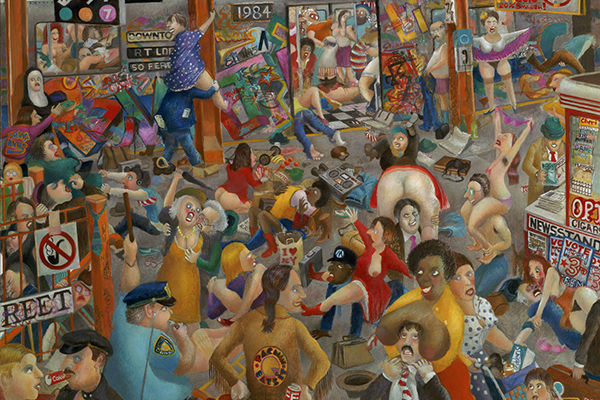
Robert Cenedella is the perennially unfashionable figurative satirical painter famous for his sardonic neo-Bregheulian depictions of teeming New York street scenes, concert venues, boxing matches, and such diverse arenas as Ground Zero and the original Le Cirque restaurant. Art Bastard, Victor Kenefsky’s infectious biographical documentary about him, takes its title from Cenedella’s actual illegitimacy and his status as a rebel—and thorn in the side of the art world’s self-protecting establishment.
Ed McCormack, managing editor of the Gallery & Studio art magazine, recalls in the film how he gave Cenedella a back cover to illustrate and was presented with a mock-Rothko, on which was scrawled the word “bullshit.” To his credit, McCormack didn’t censor it. “Bob’s a pain in the ass,” he says with no little admiration.
Robert Cenedella with Mayor Ed Koch in 1986. Courtesy Cavu Pictures.
Partially because he has never found acceptance with art’s power brokers, Cenedella has for over fifty years been the voice in the crowd unafraid to lambaste strains of Pop and contemporary art as the emperor’s new clothes. It’d be fascinating to poll moviegoers who have seen Art Bastard, because one suspects that for every skeptic who considers him a Luddite, there’d be five who endorse his nay-saying.
Structured round an interview with the plain-spoken 76-year-old, the film is clearly skewed that way. There is, for example, a marked contrast between Cenedella’s blunt denunciations of brilliantly marketed art stars and the understandably politic (if sometimes cryptic) comments of the Guggenheim’s director Richard Armstrong.
Paradoxically, Kenefsky might have strengthened Cenedella’s position by balancing the supportive comments of his on-camera supporters, who include publisher Victor S. Navasky and art appraiser Paul Zerler, with those of Andy Warhol’s and Jeff Koons’s champions. For example, an archival clip of Warhol and the late gallerist Ivan Karp smirking as they condescend to a well-meaning interviewer speaks for itself—as does hilarious footage from Cenedella’s 1966 “Yes Art” exhibition, which was his scathing riposte to Pop Art.
Robert Cenedella painting Le Cirque at Laight Street Studios in 1998. Courtesy Cavu Pictures.
Cenedella went into a voluntary ten-year exile after that show, forsaking his art career for one as a Madison Avenue artist-writer—he surely inspired Mad Men’s rough diamond Stan Rizzo! His disillusion was partly attributable to his empathy for George Grosz, the great caricaturist of Weimar Berlin’s social malaise who had mentored Cenedella at the Arts Student League of New York. A few week after returning to Berlin in 1959 (and trying to bring Cenedella with him as a stowaway), Grosz had died believing himself a failure. The thought of this brings Cenedella almost to tears. It is fitting that he inherited Grosz’s job at the League.
The illegitimate son of an English professor with whom he had a distant relationship, young Bob had been raised thinking his father was his mother’s husband, Robert Cenedella Sr., a radio writer who had refused to cooperate with the House Un-American Activities Committee during the McCarthy witch-hunts, resulting in his blacklisting and the family’s impoverishment. Both principled and feckless, Bob Sr. stole his son’s collection of $2 bills and never paid him back. Grosz tacitly served as the aspiring painter’s surrogate father. Cenedella has consciously been a loving father to his own (now white-haired) son and the film shows him cooking pasta for him and the two attending a New York Rangers game. That he’s got more than a touch of the common man is doubtless another reason why the art elite has snubbed him. Long may he prosper.
Art Bastard is currently playing in New York and opens soon at select theaters around the country.